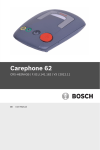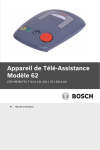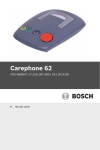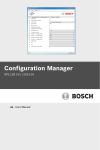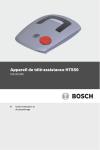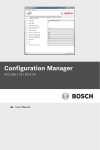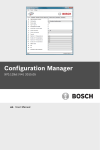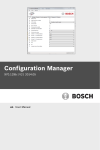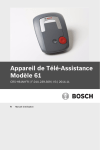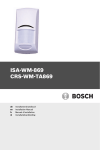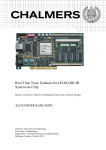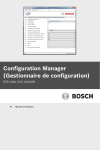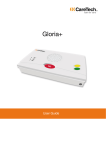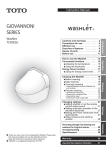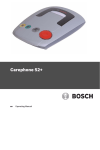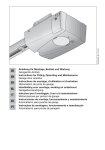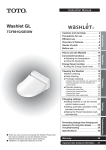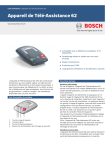Download Operating Manual (Carephone 62)
Transcript
Carephone 62 CRS-H62M-GB | F.01U.141.162 | V5 | 2014.09 en User Manual Carephone 62 Table of Contents | en 3 Table of Contents 1 Safety Instructions 5 2 Features 6 3 Scope of Delivery 7 4 Product Description 8 4.1 Unit Description 8 4.2 Emergency call button 8 4.3 Cancel / Action button (S button) 9 4.3.1 Action button: service call 9 4.3.2 Action button: direct call 9 4.3.3 Action button: unit status 9 4.3.4 Action button: manual test call 9 4.4 Daily button 10 4.5 Sign in / sign out button 10 4.6 Take the first incoming call 11 4.7 Device acknowledgments 11 4.7.1 Light signals 11 4.7.2 Local voice announcements from the unit 13 4.7.3 Error messages 14 5 Installation 15 5.1 Installation recommendations 15 5.2 Placing the Carephone 62 15 5.3 Connecting the Carephone 62 16 5.3.1 PSTN or GSM connection 16 5.3.2 IP connection 17 5.3.3 Connection configuration 17 5.4 Deinstallation 17 6 Programming 18 6.1 Programming methods 18 6.2 Programming procedure 19 6.2.1 Opening the unit and access the keyboard 19 Bosch Security Systems User Manual F.01U.141.162 | V5 | 2014.09 4 en | Table of Contents Carephone 62 6.2.2 Entering keyboard programming 19 6.2.3 Key functions during keyboard programming 20 6.2.4 Programming steps 20 6.2.5 Special key functions 31 6.3 Test mode 33 7 Additional Devices 34 7.1 Wireless transmitters 34 7.2 Wireless detectors 34 7.3 Wired peripherals 35 7.4 Microphone and loudspeaker connection 36 7.5 microSD memory card 36 7.5.1 Installing the microSD memory card 37 7.5.2 Programming with the microSD memory card 39 8 Operation 41 8.1 Emergency Call to a Monitoring Centre 41 8.2 Emergency Call to a Private Phone 41 8.3 Taking Phone Calls 43 8.4 Test instructions 43 9 Maintenance 44 9.1 Cleaning 44 9.2 Battery disposal 44 9.3 Replacing the backup battery 45 A Appendix 49 A.1 Technical specifications 49 A.2 Conformity 51 A.3 Wall mounting 51 A.4 Drilling template 53 A.5 Programming tables 56 Index 59 F.01U.141.162 | V5 | 2014.09 User Manual Bosch Security Systems Carephone 62 1 Safety Instructions | en 5 Safety Instructions CAUTION! Read through the safety instructions carefully before using the unit for the first time. This is important for connection, use and safety. – Do not install the unit near a heating appliance. – Do not expose the unit to direct sunlight. – Do not install in a wet or humid environment. – Never touch the power adapter with wet hands. – Do not attempt to open the unit or the power adapter. – When unplugging the unit from the power outlet, never pull on the power cord but always grip the power adapter. – Connect the Carephone 62 only to a professionally installed 230 V AC/50 Hz power outlet with a 10 A fuse. – Do not install the Carephone 62 in the proximity of DECT/ GSM telephones, TV sets, large metal objects, microwave appliances or radio telephones. This will impair the reception of signals from the wireless transmitter. – Use only original equipment for cables and power supply. – Electrolytes or gases may be emitted from the battery Any other power adapter could damage the unit. should it leak under exceptional circumstances. If this happens, deactivate the unit by isolating it from the phone network and power supply. Battery replacement must be carried out by trained service personnel only. Electrostatic Discharge WARNING! The Carephone 62 contains highly sensitive electronic components. It should be opened only in an ESD protected environment with respect to the following precautions. Discharge yourself from electrostatic loads by touching a grounded conductive surface before opening the unit. Bosch Security Systems User Manual F.01U.141.162 | V5 | 2014.09 6 2 en | Features Carephone 62 Features The Carephone 62 has been designed to ensure maximum security for persons living in their own homes. It can be used to send emergency calls to a receiver or a telephone. The person requiring assistance activates a call by pressing a button on the Carephone 62 or by using a wireless transmitter. This action establishes a voice connection between the person requiring assistance and the call receiver. The device has two basic operating modes: 1. The Carephone 62 is part of a social alarm system that consists of a monitoring centre that can be reached at any time and the Carephone itself. Calls are sent to this monitoring centre. 2. The unit is operated as a standalone unit, in which case emergency calls will be sent to private phones. The Carephone 62 provides connections for an external microphone and an external loudspeaker, as well as wired input and output, and a microSD memory card. It can be used with up to 10 wireless transmitters. A signaling device can also be connected for individuals with speech/hearing difficulties. microSD Logo is a trademark of SD-3C, LLC. CAUTION! No user serviceable parts inside. This unit should be tested weekly. F.01U.141.162 | V5 | 2014.09 User Manual Bosch Security Systems Carephone 62 3 Scope of Delivery | en 7 Scope of Delivery 7 ne o ph 6 62 Funknotruf Pendant alarm Alarme médaillon Handzender alarm re Ca Notruf Emergency call Appel d'urgence Alarm oproep 1 2 3 4 3 6 7 8 9 *A rM e Us l ua an 0 # B C D E F R + P Alarm stoppen Cancel alarm Stop Alarm stoppen Carephone 62 CRS-H62-PQG de Kurzprogrammieranleitung en Quick Programming Guide fr Guide de paramétrage rapide nl Verkorte Programmering 2. 5 Abmelden Away Absence Afmelden Anmelden Home Présence Aanmelden Carephone 62 1 1. Tagestaste Daily button Présence Vie Activiteitscontrole 2 3 4 Carephone 62 including a rechargeable backup battery Wireless transmitter (battery included), with necklace, clip and bracelet accessories 3. Power supply unit 4. Phone or network cable, optionally with a country-specific telephone plug 5. Quick user guide 6. Quick programming guide 7. User manual CAUTION! To reduce risk of fire and electric shock, replace only with identical components and parts. Bosch Security Systems User Manual F.01U.141.162 | V5 | 2014.09 8 en | Product Description Carephone 62 4 Product Description 4.1 Unit Description 4.2 1. Red emergency call button 2. Cancel / Action button 3. Sign in / sign out button 4. Daily button Emergency call button If you require help, press the red emergency call button to initiate a call. The call will be answered either by a person at the monitoring centre or a private individual, according to the programmed telephone number. F.01U.141.162 | V5 | 2014.09 User Manual Bosch Security Systems Carephone 62 4.3 Product Description | en 9 Cancel / Action button (S button) Cancel emergency call If you have pressed the emergency call button by mistake, you can cancel the call with the Action button during the pre-alarm time. Press the Action button until the unit announces "stop". Calls cannot be cancelled after the pre-alarm time. 4.3.1 Action button: service call You can program the Action button to act as a service button. If you press the button and hold it for at least 2 seconds, the unit dials a call number that has been programmed for the service call and you hear the announcement "service call". 4.3.2 Action button: direct call You can program the Action button to make a direct call. When the Action button is pressed, the Carephone 62 makes one single call to an analog telephone destination. In case of a call sent by a direct call, the alarm can also be cancelled after the pre-alarm. A direct call is not possible with an IP connection. 4.3.3 Action button: unit status The Action button lights up if there is a malfunction. Press the Action button, the status is announced. 4.3.4 Action button: manual test call The Action button can be used to send out manual test calls. Press the button for at least 2 seconds, the Carephone 62 will send a manual test call. Step 71 must be set to setting 4. See Section 6.2.4 Programming steps, page 20. Bosch Security Systems User Manual F.01U.141.162 | V5 | 2014.09 10 en | Product Description 4.4 Carephone 62 Daily button The Carephone 62 has a built-in activity monitor, which ensures that an emergency call is made automatically if the daily button is not pressed within a preset period of time. The lamp on the daily button lights up when it should be pressed. The activity monitor can also be reset by a transmitter. The daily button is also used for presence marking by staff : 4.5 – press 2 seconds upon arrival. – press shortly upon departure. Sign in / sign out button Pressing the sign in / sign out button tells the unit whether you are currently at home or not. Sign out When you leave home, press the sign in / sign out button. You hear the announcement "sign out ". The activity monitor is temporarily disabled. Sign in When you return home, press the sign in / sign out button again. You hear the announcement "sign in". NOTICE! Calls can be made with the emergency call button or a wireless transmitter at any time, even after a sign out. This signs you in. F.01U.141.162 | V5 | 2014.09 User Manual Bosch Security Systems Carephone 62 4.6 Product Description | en 11 Take the first incoming call If your Carephone 62 is delivered to you unprogrammed, this special function allows you to accept the first incoming call. Press buttons <Yellow> <Green> <Grey> together for at least two seconds. If the first incoming call is from your monitoring centre, the operator can start a remote programming session. See Section Remote programming from a monitoring centre, Page 18. NOTICE! When pressing these 3 buttons, English is set as the default language. See Section 6.2.4 Programming steps, Page 20. 4.7 4.7.1 Device acknowledgments Light signals The Carephone 62 has four indicator lamps that display the status of the unit. The symbols have the following meaning: Lamp shines bright Lamp shines dull Lamp blinks (0.5 s) Lamp blinks fast (0.5 s) Lamp flashes (0.1 s) Bosch Security Systems User Manual F.01U.141.162 | V5 | 2014.09 12 en | Product Description Carephone 62 Status Description or Action Initialization After power on. Error Error message is Yellow Green Blue Red announced once. Press Action button to repeat. Standby normal mode Unit is in standby. Standby battery operation Standby mode with the Action button set as service button Pre-alarm Cancel with Action button. Connection Establish connection. Speak Speak (for the hearing impaired) Listen Listen (for the hearing impaired) Repeated call When a call is repeated. Call activated If the call not acknowledged, a new call is sent. Call back waiting Pressing Action button time acknowledges the alarm Signed out, The sign in / sign out normal mode button has been Signed out, pressed. The activity battery operation monitor is inactive. F.01U.141.162 | V5 | 2014.09 User Manual Bosch Security Systems Carephone 62 Product Description | en Status Description or Action Yellow Green Blue 13 Red Signed in, normal mode Activity monitor is Signed in, active. Press the daily battery operation button every day. Active time frame, normal mode Press the daily button Active time frame, now. battery operation Pre-alarm activity Cancel with the daily monitor button. Sign in by staff 4.7.2 Local voice announcements from the unit When pressing a button Voice announcement Meaning "Emergency call" When the emergency call button is pressed. "Call activated" Connection failed - unit is calling again. "Stop" When the action button is pressed during the prealarm. The call is cancelled. "Service call" When the action button is pressed, if it is programmed as a service button or direct call. "Emergency call cleared" When a repeated call is acknowledged on the unit. "Call ended" When a call back is acknowledged on the unit. "Radio button [x]" When a wireless transmitter is pressed, x being "Sign in" When the sign in / sign out button is pressed. "Sign out" When the sign in / sign out button is pressed. "Activity monitor, press Message before the activity monitor expires. yellow button please" Press the daily button to reset. the number of the transmitter, from 1 to 10. Bosch Security Systems User Manual F.01U.141.162 | V5 | 2014.09 14 en | Product Description Carephone 62 Voice announcement Meaning "Activity monitor reset" When the daily button is pressed before the end of the time frame. "Alarm input" 4.7.3 When the external alarm input is activated. Error messages Error messages are announced locally by the Carephone 62. When the Carephone 62 is in synthetic speech disabled mode, the error messages are announced by sound signals only. Voice Synthetic speech Meaning and Action needed announcement disabled mode "Power failure" 1 beep Main power failure. Check the power connection. "Line failure" 2 beeps Connection to the telephone network has been lost. Check the connection. "Unit battery 3 beeps empty [x]" A backup battery is empty, x being either the battery of the Carephone (1), or the battery of the GSM Module (2). If both batteries are concerned, the unit announces "Unit battery empty 1, 2". Connect to the main power supply. "Transmission 4 beeps failure" F.01U.141.162 | V5 | 2014.09 Emergency call not sent. Contact monitoring centre. User Manual Bosch Security Systems Carephone 62 5 Installation | en 15 Installation CAUTION! Before installing and programming the Carephone 62, read the safety instructions carefully. 5.1 Installation recommendations – Place the unit on a flat and non-slippery surface. – Do not install on soft surfaces as this impairs voice quality. – Do not cover the microphone (right-hand side of the unit). – Alarms are not sent if the telephone line or the IP – The Carephone must be connected with the power supply. connection are out of order. – To send an alarm, at least one alarm receiver (a monitoring centre or a private phone) and the subscriber number must be programmed. – The power adaptor of the Carephone 62 must placed at least 10 cm away. – When using the Carephone 62 with a GSM gateway, place them at least 1 m from each other. – When using wireless speakers next to the Carephone 62, place them at least 4 m away. Be aware that some loudspeakers, if they use the same frequency as the Carephone 62, could influence the radio reception. – Construction materials affect the range of the transmitter. For example, concrete walls with steel reinforcements hamper the radio signal more than a brick wall. – Location of the Carephone 62 affects the range of the transmitter. The best place to locate it is a central room. 5.2 Placing the Carephone 62 Placing on a surface The Carephone 62 is designed for use at home. Many items of furniture are coated with a variety of paints, varnishes and plastics. The feet of the Carephone 62 may leave marks on furniture as a result of chemical processes. Bosch Security Systems User Manual F.01U.141.162 | V5 | 2014.09 16 en | Installation Carephone 62 Wall mounting You can set the Carephone 62 to the wall either using a wall bracket that can be ordered as an accessory, or you can fix the unit directly to the wall without a bracket. The wall bracket stabilizes the Carephone 62 and makes installation easier. See Section A.3 Wall mounting, page 51. 5.3 Connecting the Carephone 62 5.3.1 PSTN connection 1. Insert the plug of the telephone cord into the socket (1) on the Carephone 62. Feed the cords through the cable channels and through the opening on the back of the unit. 2. Fit the plug of the telephone cord into the socket of your 3. Insert the plug of the main power adapter into the socket telephone outlet or GSM gateway. (2) on the Carephone 62. CAUTION! Only connect the unit to a phone outlet that has been correctly installed by your telephone service provider. The Carephone 62 is designed to be connected to the public telephone network. 4. Plug the power adapter into the line power outlet. All the indicator lamps light up for approx. 2 seconds, this is a battery test. The unit offers a choice of languages and after selection enters standby mode (see Section 6.2.4 Programming steps, page 20). The unit can now be programmed. F.01U.141.162 | V5 | 2014.09 User Manual Bosch Security Systems Carephone 62 Installation | en 17 NOTICE! The backup battery will now charge up. The specified standby time is available when the battery is fully charged, after 16 hours. If the Carephone 62 is stored and disconnected, connect it to the main power supply at least once every 6 months, to allow the battery to charge. 5.3.2 IP or GSM connection Refer to the user manuals of the IP Module and the GSM Module. When using an IP or GSM connection, be aware of potential limitations due to network availability. In case of a DSL equipment, be aware of power failures. Prioritizing an emergency call may not always be possible. 5.3.3 Connection configuration NOTICE! In the event of an emergency, the unit must be able to send out an emergency call even if a phone call is in progress at the time. The Carephone 62 must interrupt the phone call. To check whether an emergency call can be sent: 1. Make a phone call as you normally would. 2. When the phone call is in progress, press the red button. If the setup is correct, the phone call will be interrupted. CAUTION! With a private branch exchange (PABX) there is no guarantee that a phone call will be interrupted by the emergency call. 5.4 Deinstallation To switch off the Carephone 62 and the backup battery, remove the power plug from the unit. NOTICE! If you remove the power plug from your power outlet, the unit announces "power failure". The unit will switch to battery operation. Bosch Security Systems User Manual F.01U.141.162 | V5 | 2014.09 18 en | Programming 6 Carephone 62 Programming Before you program the Carephone 62 you must be familiar with all of the unit's functions. Programming is specifically intended for trained users. NOTICE! Correct programming of the Carephone 62 is important for the full function of the unit. 6.1 Programming methods The Carephone 62 can be programmed in different ways: Local programming with the keyboard Use the integrated keyboard to program the unit. Programming with a microSD memory card See Section 7.5 microSD memory card, page 36. Remote programming from a monitoring centre Connect the Carephone 62 to the monitoring centre by pressing the emergency call button. The monitoring centre can now download parameters to your Carephone 62. NOTICE! Check with your monitoring centre the remote programming possibilities. F.01U.141.162 | V5 | 2014.09 User Manual Bosch Security Systems Carephone 62 6.2 6.2.1 Programming | en 19 Programming procedure Opening the unit and access the keyboard To access the keyboard, open the unit by lifting the top cover. NOTICE! A quick programming guide is provided on the back side of the cover of the unit. It is intended for experienced users who are familiar with programming the Carephone 62. 6.2.2 Entering keyboard programming 1. On the keyboard, press P at least one second. The unit announces "Setup" and the version. 2. Enter the Personal Identification Number (PIN). The PIN factory setting is 246810. If the PIN is entered correctly, the unit announces "Selection". 3. On the keyboard, enter the programming step you wish to change. The steps can be carried out in any order. 4. Enter the new setting as required. 5. Press C to confirm your entries. The Carephone 62 automatically goes to the next programming step or substep. 6. To leave the programming mode, press **. Bosch Security Systems User Manual F.01U.141.162 | V5 | 2014.09 20 en | Programming 6.2.3 Carephone 62 Key functions during keyboard programming The following key functions can be used at any time. C Save new settings and go to the next programming step. Settings that are not confirmed with C will not be saved! A The setting of the programming step is erased. * Return to the beginning of the programming mode. The Carephone 62 announces "Selection". ** Terminate programming. The Carephone 62 announces: "Setup ended". Programming also terminates automatically if no entries are made for 10 minutes. 0 to 9 Enter the programming data. P The Carephone 62 announces the programming step’s number and current setting. R Reset the Carephone 62. It will then emit a beep. All pending alarms/calls are cancelled and the Carephone 62 reboots. 6.2.4 Programming steps Programming the Carephone 62 consists of individual steps, numbered 01 to 99. A programming step consists of a number and an associated setting. Press the number of the step that you want to access. 01 Language selection When the Carephone 62 is powered on, it announces different languages: – 1 = German, 2 = Dutch, 3 = French, 4 = English, 5 = Spanish, 0 = synthetic speech disabled. There is no default setting. 03 Radio jamming The Carephone 62 sends a technical message to the monitoring centre when a radio signal from another device disturbs it. – 0 = off, 1 = on. Default value is 0. 05 RB2000 & RB2000E alternative connection It is possible to change the connection mode for the RB2000 and RB2000E protocols. 0 = normal connection, 1 = alternative connection. Check the compatibility with your alarm receiving center. Default value is 0. F.01U.141.162 | V5 | 2014.09 User Manual Bosch Security Systems Carephone 62 Programming | en 21 11- 19 & 10 Destination number of the emergency call recipient You can enter here the destination number of the emergency call recipient, either a telephone number, or an IP address. 1) Enter the destination number of the emergency call recipient. In the case of a telephone number, register the call number as follows: You can add the following criteria in a telephone call number: B = Dial pause, D = Dial tone detection. In the case of an IP address, the call number should be written in numbers without dots, always 12 digits. Example: 192168010001. Confirm with C. 2) After entering the call number, you must enter the protocol: – 0 = monitoring centre (protocols RB2000, RB2000E, ANT) – 1 = monitoring centre (TTnew+ protocol) – 3 = monitoring centre (CPC protocol) – 4 = to phone with acknowledgement – 5 = to phone without acknowledgement (only for direct call) – 7 = monitoring centre (BS8521 protocol) – 9 = monitoring centre (RBIP protocol) Settings 0 to 7 are designed to be used with the media PSTN. Setting 9 is designed to be used with the IP Module or GSM Module. 3) If you enter the protocol with 1 digit, the media setting is not available. If you enter the protocol with 2 digits (ex: ’09’), you can enter the media: – 0 = PSTN, related to the analogue interface of the Carephone. This also applies with a GSM Gateway or a DSL/cable modem. – 1 = LAN, related to the IP Module – 2 = GSM, related to the GSM Module The Carephone 62 goes automatically to the next programming step and you can enter the next call number. When an emergency call is sent and if the call to the first call number is not successful, the Carephone 62 will try the next numbers in the sequence 11 to 10. If the last number has been dialed unsuccessfully, the unit starts with the first number again and continues until it sends an emergency call successfully. A single programmed telephone number will be tried 12 times. The maximum number of dial attempts can be set. By default, it is set to 15 attempts. Bosch Security Systems User Manual F.01U.141.162 | V5 | 2014.09 22 en | Programming Carephone 62 23 Waiting time for repeated emergency call An emergency call is repeated to check the arrival of staff until it is acknowledged by pressing the Action button on the Carephone 62, or the repeated call is disabled by the monitoring centre. The emergency call is repeated when the defined waiting time is exceeded. – Enter a time between 0 and 99 minutes. 0 = off. Default value is 0. 24 Confirmation with call When the repeated emergency call has been locally acknowledged, you can speak directly to the monitoring centre. – 0 = off (no call is made), 1 = a call is made to the monitoring centre. Default value is 0. 25 Radio transmission monitoring The Carephone 62 can monitor the wireless transmitters that are assigned. The wireless transmitters send a signal to the Carephone 62 at regular intervals. A failure message is sent to the monitoring centre if the Carephone 62 does not receive this signal at least once a week. – 0 = off, 1 = on. Default value is 0. 26 Call back waiting time The call back function enables the help provider or monitoring centre to terminate an alarm after having acknowledged it. The Carephone must be called back, or the Action button must be pressed, after an alarm has been acknowledged. Define the waiting time after the acknowledgement, during which a call back will be accepted. If this call back waiting time has elapsed, then a new call will be sent by the Carephone. – Enter a time between 0 and 9 minutes. 0 = off. Default value is 0. 27 Presence marking - Service done The presence marking function allows staff members to mark their presence or signal that the service is done by pressing the daily button. This is handled without a speak/listen connection and does not require an answer by the operator. When the presence marking is activated, the destination numbers to be called are set in the call sequence of step 58. This function resets the activity monitor, which must be set. See step 40. – 0 = off, 1 = on. Default value is 0. F.01U.141.162 | V5 | 2014.09 User Manual Bosch Security Systems Carephone 62 Programming | en 23 28 Call forwarding It is possible for the monitoring centre (if it supports this functionality) to ask the Carephone 62 to forward the current call to a new destination using a specified protocol. This step is used to allow the Carephone 62 to use the specified protocol, or to force it to use telephone protocol. This function is only possible with protocols RB2000E (target 0), CPC (target 3) and RBIP (target 9). – 0 = forwarding to another number, 1 = forwarding to a telephone. Default value is 0. 29 Hear/speech impaired This function is dedicated to users with speaking or hearing difficulties. Once a connection to the monitoring centre has been established, the signaling device is activated to advise the user that he or she is through to the monitoring centre (the centre is listening). If the user now presses the emergency call button again, the message emergency call is sent to the monitoring centre. If the stop button is pressed, then the recorded message (e.g. "everything is okay") is sent to the monitoring centre. – 0 = off, 1 = on (see also programming step 72). Default value is 1. 30 Device number When an emergency call is made, this number is sent to the monitoring centre. The number can be up to 12 digits long. Numbers 0000, 9998, 9999 and 999999 may not be used. Default value is 1248. 31 Sign in / sign out To specify whether the sign in or sign out of the activity monitor will initiate a call to a call recipient, choose: – 0 = without call, 1 = with call. Default value is 0. 32 Call progress tones audible You can choose to hear the call progress tones when the Carephone makes a call. – 0 = not audible, 1 = audible. Default value is 0. Bosch Security Systems User Manual F.01U.141.162 | V5 | 2014.09 24 en | Programming Carephone 62 33 Speak / Listen command audible You can choose to hear the commands when the Carephone switches between speak and listen in half-duplex mode. – 0 = not audible, 1 = audible. Default value is 1. 34 Personal voice recording For calls to telephone connections, a recorded message can be sent instead of the subscriber's number. Maximum message length is 10 seconds. a. Press D to start recording. b. The unit announces "This is the social alarm unit". A signal tone c. Speak your message. d. Recording is ended with a signal tone. e. Press F to play back your voice recording. introduces the recording of your message. To delete your voice recording, press the A key. To end the recording early, press the E key. This function is only available through keyboard programming. 40 Activity monitor The time for the activity monitor can be set between 15 minutes and 31 hours in steps of 15 minutes. a. Enter the number of hours (example: 24 for 24 hours). b. Press C to confirm. c. Enter 0 for 0 min, 1 for 15 min, 2 for 30 min and 3 for 45 min. d. Press C to confirm. Programming 00 (0 hours and 0 minutes) deactivates the activity monitor. Programming 99 means the time frame is set by the monitoring centre or through an SD card. This can only be used if the time and date are set. This can be done through keyboard programming, Configuration Manager with serial serial connection or via a remote date/time update from a receiver. Special feature for passive alarms: It is also possible to program an automatic activation of the sign out status. To activate this special feature, enter 4 for 0 min, 5 for 15 min, 6 for 30 min and 7 for 45 min. In this case, any intrusion alarm will be silent. To use this mode, at least one transmitter must be programmed as a motion detector (see programming steps 80 to 89). Default value is 00. F.01U.141.162 | V5 | 2014.09 User Manual Bosch Security Systems Carephone 62 Programming | en 25 41 to 49 IP Module and GSM Module programming steps Refer to the user manuals of the IP Module and the GSM Module, these are optional steps. 50 to 58 Alarm type links It is possible to link an alarm type to specific call numbers. Each programming step refers to a certain alarm type. – 50: wireless transmitter (emergency call with a wireless transmitter) – 51: emergency call (with the Carephone 62) – 52: fire / intrusion – 53: repeated emergency call and local confirmation – 54: sign in / sign out – 55: service call / direct call. The direct call can only made to a telephone without acknowledgement. A single attempt will be made. – 56: technical messages 1 (power failure, power restored, unit battery failure, unit battery low, line failure, line restored) – 57: technical messages 2 (automatic test call, radio jamming, radio transmission monitoring, transmitter battery low) Choose which destination numbers 1 to 10 are associated with each alarm type (call sequence). If no destination number is entered, then all programmed call numbers will be called. It is not possible to have the same destination number twice. – 58: registration call / presence marking - service done Registration call: after an emergency call, the destination number entered in setting 58 will be called for registration purposes. The call destination must be a monitoring centre. Presence marking - service done: see step 27. Choose which call numbers 1 to 10 are associated with this alarm type (call sequence). If no destination number is entered, then no call is made. It is not possible to have the same destination number twice. 60 Number of announcements when calling a telephone Specify how often the Carephone will announce the recorded message. – 0 = no announcement, from 1 to 9 for the required number of announcements. Default value is 2. Bosch Security Systems User Manual F.01U.141.162 | V5 | 2014.09 26 en | Programming Carephone 62 61 Incoming call recognition Incoming phone calls can be accepted and terminated by the Carephone 62’s emergency call button or by using the wireless transmitter if it is programmed for emergency call initiation. The ring tone on the Carephone 62 can be switched on or off and the volume can be adjusted. – 0 = off (no incoming call can be answered and terminated by the wireless transmitter or call button) – 1 = with ring tone – 2 = with loud ring tone – 3 = with soft ring tone – 4 = without ring tone (only the phone rings) – Default value is 0. 62 Loudspeaker volume This step is used to program the default volume as well as the maximum and minimum settings. The default volume is the volume at which the monitoring centre communicates via the Carephone 62. Minimum setting is low volume. Maximum setting is high volume. Both can be adjusted by the monitoring centre during a call. Use settings 1 to 8 to program these three volumes. Default values are 4, 6 and 2. 63 Acoustical feedback for technical failures The Carephone 62 can be set to announce technical failures through the LED lamps and the loudspeaker, or through the LED lamps only. – 0 = loudspeaker off – 1 = loudspeaker on – 2 = loudspeaker on from 7:00 to 21:00 – 3 = an acoustical failure indication (message or beep) shall be repeated with a pause of 10 seconds until the Action button is pressed. – 4 = an acoustical failure indication (message or beep) shall be repeated during day time (from 7:00 to 21:00) with a pause of 10 seconds until the Action button is pressed. Settings 2 and 4 are only available if the time and date are set. This can be done through keyboard programming, Configuration Manager with serial connection or via a remote date/time update from a receiver. F.01U.141.162 | V5 | 2014.09 User Manual Bosch Security Systems Carephone 62 Programming | en 27 70 Automatic test call interval You can program the interval between automatic test calls from the Carephone 62 to the monitoring centre in days. In addition, there is a test call after power up or leaving programming mode, as well as a test call per randomization. – Select from 1 to 28 days. – 0 = off – Default value is 0. 71 Action button (S button) The Action button can be configured differently according to your needs: – 0 = off – 1 = service button / direct call (e.g. service call to a monitoring centre or direct call to a relative) – 3 = activate relay output (e.g. a door opener) – 4 = send a manual test call (by pressing at least 2 seconds on the action button) – Default value is 0. 72 Activate output The Carephone 62 provides a potential-free relay output with a normally open switch contact. The way the output reacts can be programmed. – 0 = off – 1 = speak / listen connection and repeated emergency call – 3 = outgoing emergency call – 4 = incoming call recognition – 5 = wireless transmitter – 6 = remote activation – 7 = speak / listen connection – 8 = pre-alarm – 9 = pre-alarm and speak / listen connection – Default value is 0. Bosch Security Systems User Manual F.01U.141.162 | V5 | 2014.09 28 en | Programming Carephone 62 73 Assign input The Carephone 62 provides external inputs. The function assigned can be programmed: – 0 = external activity monitor reset – 1 = emergency call button – 2 = service call – 3 = external input – 9 = fire alarm – B = motion detection – Default value is 0. After your choice, the input can be chosen as a: – 0 = normally open contact (closing) – 1 = normally closed contact (opening) 74 Silent alarm The Carephone 62 can send silent alarms. When this is activated, the loudspeaker of the Carephone 62 is turned off. Only the microphone remains active. – 0 = off, 1 = on. Default value is 0. 75 Individual PIN code The Carephone 62 is delivered with the factory setting 246810 for the PIN code. It is recommended not to change this code. If you need to change this code, take care to write it down to find it easily. The PIN code is reset when resetting the unit to its factory settings. 77 Pre-alarm time The pre-alarm time of the Carephone 62 can be programmed. This is the time within which an emergency call that has been initiated can still be stopped. – Select a setting, in steps of 10 seconds, between 0 and 6. – 0 = off, 1 = 10 s, 2 = 20 s, etc. Default value is 1. F.01U.141.162 | V5 | 2014.09 User Manual Bosch Security Systems Carephone 62 Programming | en 29 81-89 & 80 Assigning wireless transmitters Registered wireless transmitters can be programmed to trigger different alarm functions, e.g. a fire alarm. First, register the wireless transmitters on the Carephone 62: refer to programming steps 90-99. To assign a function to the wireless transmitter 91, select programming step 81. – 0 = emergency call with a wireless transmitter (see step 50) – 1 = emergency call with the Carephone 62 (see step 51) – 2 = activity monitor reset with unit feedback (wireless daily button) – 3 = sign in / sign out (see step 54) – 4 = action button (see step 71) – 5 = external input (when step 73 is set to 3) – 6 = activity monitor reset without unit feedback (motion detection) – 7 = connection to a destination number (with acknowledgement), then enter the call sequence as a second parameter. First, press A to delete the current value, then choose which call numbers 1 to 10 are associated with this alarm function. – 8 = output assigned in programming step 72 – 9 = fire alarm – B = motion detection – D = extended programming (access to these parameters with a microSD memory card or remote programming) If you have selected D in steps 81, 82, etc, you can choose the extended transmitter type (111, 112, etc): – Panic alarm – Bogus call alarm – Stove alarm – Fall detector – Bed alarm – Gas alarm – CO alarm – Contact detector alarm – Temperature alarm – Flood detector alarm – Pull switch alarm – Use the custom alarm type and event handler : see steps 201, 202, etc Bosch Security Systems User Manual F.01U.141.162 | V5 | 2014.09 30 en | Programming Carephone 62 You have also access to extended programming features: In steps 121, 122, etc, select the activation start and end time for each RF detector, in steps of 15 minutes. In steps 201, 202, etc, select the custom alarm type for each RF detector. It must be a 3-digit value from 0 to 999. CAUTION! Steps 201, 202, etc. must only be used in case of a transmitter in BS8521 protocol! Otherwise, alarms will not be transmitted! Select also the custom event handler: – emergency event (personal). Choose this setting in the case of a person triggering the alarm. Notice: this resets the activity monitor. – emergency event (environmental) Choose this setting in the case of a non-personal event triggering the alarm, such as a detector. – silent event, with the listen-in function. The alarm receiving centre has the ability to control the speak/listen connection. In steps 251, 252, etc, select the location code for each RF detector. Choose a number between 0 and 99 corresponding to a location code as described in the BS8521 protocol. CAUTION! The setting use the custom alarm type and event handler and steps 251, 252, etc. must only be used in case of a transmitter in BS8521 protocol! Otherwise, alarms will not be transmitted! F.01U.141.162 | V5 | 2014.09 User Manual Bosch Security Systems Carephone 62 Programming | en 31 91-99 & 90 Registering wireless transmitters Up to 10 wireless transmitters or detectors can be registered directly on the keyboard with a code number contained in the transmitter itself. These code numbers must be stored in the Carephone 62. To register a wireless transmitter: a. Select programming step 91. b. The Carephone 62 announces: "Selection 91 is..." c. Press the button of the corresponding wireless transmitter. d. The Carephone 62 announces: "Selection 91 is..." e. Press C to confirm. The wireless transmitter is now stored. Restoring the factory settings deletes all registered wireless transmitters. If you wish to program the next 10 wireless transmitters (numbered 11 to 20), this can be done only with the Configuration Manager or Alarm Management Systems. 6.2.5 Special key functions Restore the programming steps to the factory settings – Press P and R together for at least two seconds. – The unit announces: "Setup reset". The unit is now ready for language selection. CAUTION! This function deletes all user settings and restores the factory settings instead! Reset the Carephone 62 – Press R for at least one second. The unit emits a beep and the unit reboots. Easy wireless transmitter registering on the keyboard – Press P, 9 and 1 together for at least two seconds. – The unit waits for a wireless signal. – Press the button of the wireless transmitter. – Press C to confirm. The code number of the wireless transmitter is registered in Selection 91 (erasing the previous code number). Bosch Security Systems User Manual F.01U.141.162 | V5 | 2014.09 32 en | Programming Carephone 62 Easy wireless transmitter registering with top-cover installed – Press buttons <Yellow> <Green> together for at least two seconds. – The unit waits for a wireless signal. – Press the button of the wireless transmitter. – The unit acknowledges with a beep. – Press the button of the same transmitter to confirm. – The unit acknowledges with two beeps. The code number of the wireless transmitter is registered in Selection 91 (erasing the previous code number). Enter easy unit ID programming – Press P, 3 and 0 together for at least two seconds. – The unit goes directly to Programming Step 30. – Type the unit ID (device number) with numeric keys, the unit ID can be up to 12 digits long. – Press C to confirm. Remote programming (incoming) – Press buttons <Yellow> <Green> <Grey> together for at least two seconds. The device acknowledges by announcing "Setup activated" and enters the incoming remote programming mode. Set date and time with the keyboard – Press P and B together for at least 2 seconds. – The four indicator lamps light up bright. – The Carephone 62 announces "setup B", then announces the current date and time value in the format DD MM YYYY HH MM as a list of digits. – Enter the value of the date and time in the above format, using keys 0 to 9. As soon as 12 digits are entered, the input is evaluated to determine if the date & time are valid. There is no need to confirm with C. – The Carephone 62 plays a sound when the input is valid or announces "failure" if it is incorrect. If it is incorrect, type it again. – Exit the date and time programming mode by pressing *. F.01U.141.162 | V5 | 2014.09 User Manual Bosch Security Systems Carephone 62 Programming | en 33 NOTICE! If your Carephone 62 is reset or experiences a power down, the date and time are reset to the default value 270520091830. In this case, the following functions are disabled: – activity monitor in setting 99 (see step 40) – acoustical feedback in settings 2 and 4 (see step 63) – RF activation start and end time (see steps 121, 122, etc) This is valid until the Carephone 62 sends an alarm to a monitoring center, allowing to set date and time remotely. 6.3 Test mode You can set the Carephone 62 into test mode. Pressing the wireless transmitter or the emergency call button generates an acoustical signal without starting an alarm. Enter test mode – Press P and A together for at least one second. – The Carephone 62 announces "test". – Press 9, 0 and C. During 3 minutes, the red lamp flashes every two seconds and the Carephone 62 emits a short beep every five seconds. – Press the button of a registered wireless transmitter. – When the Carephone 62 receives the signal from a registered wireless transmitter, it emits a long beep. NOTICE! Every time the Carephone 62 receives a signal from a registered wireless transmitter, the three-minute time frame is reset. If no signal is received, the Carephone 62 returns to standby. Bosch Security Systems User Manual F.01U.141.162 | V5 | 2014.09 34 en | Additional Devices Carephone 62 7 Additional Devices 7.1 Wireless transmitters The wireless transmitter that is supplied with the Carephone 62 is designed to make emergency calls and allows you to move around your home within radio range. Always carry the wireless transmitter with you when you are at home. To make an emergency call using the wireless transmitter: – press the button on the wireless transmitter. – The indicator lamp lights up once as confirmation. – The Carephone 62 announces "radio button [x]" (x being the number of the transmitter) and the call is activated. An emergency call made by mistake can be cancelled during the pre-alarm by pressing the Action button on the Carephone 62. CAUTION! The radio range between the wireless transmitter and the Carephone 62 depends largely on the environment in which the devices are used. Test the range within your own environment! 7.2 Wireless detectors You can register up to 10 wireless detectors when using the keyboard and up to 20 wireless transmitters when using the Configuration Manager or Alarm Management Systems. These wireless transmitters, for example a smoke detector or a motion detector, can be registered in the Carephone 62. These detectors must be registered according to programming step 91-99 & 90 Registering wireless transmitters. At installation, these detectors can have an input assignment, see programming step 81-89 & 80 Assigning wireless transmitters. F.01U.141.162 | V5 | 2014.09 User Manual Bosch Security Systems Carephone 62 7.3 Additional Devices | en 35 Wired peripherals A socket to connect an external input is provided on the back of the Carephone 62. The relay output and an external device are connected using a cord with an RJ45 plug. NOTICE! Before you install and connect an external wired device, disconnect the Carephone 62 from the telephone line and power supply. Explanation of the pin functions Pin view Bosch Security Systems RJ45 plug Function Pin 1 Tx Pin 2 external input GND Pin 3 Rx Pin 4 not used Pin 5 relay output NC (normally closed) Pin 6 relay output C (common) Pin 7 relay output NO (normally open) Pin 8 external input signal User Manual F.01U.141.162 | V5 | 2014.09 36 en | Additional Devices 7.4 Carephone 62 Microphone and loudspeaker connection An external microphone and an external loudspeaker can be connected. Open the top cover of the unit and remove the battery pack cover to access the compartment. Locate the sockets of the microphone (1) and loudspeaker (2) and plug in the corresponding jacks. Fasten the cables into the channels on the battery pack cover. 2 1 7.5 microSD memory card The Carephone 62 can be equipped with a microSD memory card to perform a fast and easy programming. First, install the microSD memory card. NOTICE! Use a microSD memory card of 32 GB capacity or lower. F.01U.141.162 | V5 | 2014.09 User Manual Bosch Security Systems Carephone 62 7.5.1 Additional Devices | en 37 Installing the microSD memory card CAUTION! When inserting or removing the microSD memory card, make sure that the power supply unit is disconnected from the socket on the back of the Carephone 62. See Section 5.3.1 PSTN connection, page 16, socket number 2. 1. Remove the plug of the power supply unit from the socket on the Carephone 62. 2. Open the top cover of the unit to access to the connection compartment. The location of the microSD port is indicated in the following diagram. 3. Take the microSD memory card in the hand and place it with the contacts facing you, as on the drawing. Bosch Security Systems User Manual F.01U.141.162 | V5 | 2014.09 38 en | Additional Devices 4. Carephone 62 Insert the microSD memory card in the slot and push it until you feel the mechanism has clutched it. 5. Insert the plug of the power supply unit from the socket on 6. Perform the programming action that you wish. See the Carephone 62. Section 7.5.2 Programming with the microSD memory card, page 39. 7. When you are finished and wish to remove the microSD memory card, remove the plug of the power supply unit from the socket on the Carephone 62. 8. To disengage it from the slot, simply push on the end of the microSD memory card and gently pull it out. F.01U.141.162 | V5 | 2014.09 User Manual Bosch Security Systems Carephone 62 7.5.2 Additional Devices | en 39 Programming with the microSD memory card Programming the Carephone 62 with the microSD memory card consists of calling up different programming functions. These programming functions are executed with special key combinations. NOTICE! Before programming with the microSD memory card, make sure that the Carephone 62 is connected to the mains with the power supply unit. Press the key combination of your choice and the unit will perform the function associated to it. NOTICE! Before reading from the microSD memory card, make sure that it contains a file. Before writing to the microSD memory card, make sure that it is not write-protected. Existing files with same names will be overwritten. Read settings from the microSD memory card to the Carephone 62: Function Press together for at least 2 seconds: Read factory settings P, F and 1 Read user settings P, F and 2 Read firmware P, F and 3 Restricted read user settings (programming steps 30, 47, 49 P, F and 4 and 91 are not modified) NOTICE! After reading the firmware to the Carephone 62 (key combination P, F and 3), make sure to perform a test alarm. See Section 8.4 Test instructions, page 43. Bosch Security Systems User Manual F.01U.141.162 | V5 | 2014.09 40 en | Additional Devices Carephone 62 Write settings from the Carephone 62 to the microSD memory card: Function Press together for at least 2 seconds: Write factory settings P, D and 1 Write user settings P, D and 2 Write the event history: the last P, D and 3 500 events within the Carephone 62 are copied into a file on the microSD memory card. In all cases, the unit beeps and the corresponding settings are copied into a file on the microSD memory card. When it has finished, the unit beeps again and returns to standby. F.01U.141.162 | V5 | 2014.09 User Manual Bosch Security Systems Carephone 62 Operation | en 8 Operation 8.1 Emergency Call to a Monitoring Centre 41 How the emergency call is processed at the monitoring centre 1. Initiate an emergency call with the Carephone 62 or the wireless transmitter. 2. 8.2 The emergency call is sent. 3. An operator at the monitoring centre takes your call. 4. Speak to the operator. 5. Wait until assistance arrives. Emergency Call to a Private Phone The Carephone 62 can be programmed to send an emergency call to a private phone. The emergency call from the Carephone 62 is received just like a normal phone call. How the emergency call is received on a private phone line 1. Initiate an emergency call with the Carephone 62 or the wireless transmitter. 2. The emergency call is sent. 3. The person picks up the phone. 4. The Carephone 62 announces immediately "call, call" to the person rendering assistance. 5. This is followed by an announcement telling the person how the emergency call was made, e.g. with the emergency call button or the wireless transmitter, and who made it. 6. The announcement can be repeated as often as required by pressing 2 on the phone. 7. When the announcement ends, a speak / listen connection in hands-free mode is set up between the person calling for assistance and the person answering the call. 8. The call remains connected for approx. 3 minutes. Three tones sound when this time has expired. Press 0 to terminate the call. Bosch Security Systems User Manual F.01U.141.162 | V5 | 2014.09 42 en | Operation Carephone 62 CAUTION! If the person receiving the emergency call hangs up without pressing 0, the alarm is not be properly processed. The Carephone 62 considers that the alarm is still ongoing and automatically dials the next destination number in the programmed sequence. If only one destination number is programmed, that same number will be called again. 9. Extend the call by 3 extra minutes by pressing 1 on the phone. The call can be extended as often as required. NOTICE! Instead of the subscriber number, a personal message can be recorded, e.g. "This is Mrs. Brown's emergency call unit...", see Step 34 in the programming section. Key functions on the destination phone When the destination number is in telephone protocol, the respective key function needs to be pressed twice in order to confirm the selection. See programming steps 11-19 & 10. Key Function 0 Terminate and acknowledge the call. 1 Extend the call by another 3 minutes. 2 Repeat the alarm message. 3 Speak with normal volume to the Carephone 62. 4 Listen to the Carephone 62. 5 Increase the volume and speak to the Carephone 62. 6 Reduce the volume and speak to the Carephone 62. 7 Interrupts all messages played by the Carephone 62 and switches to duplex mode (two-way operation). 8&0 Cancel the repeated call function for the call by pressing 8 then 0. 9 Reject the call and terminate. The Carephone 62 dials the next number on the list. # Remote activation of the relay output, only when programming step 72 is set to 6, see Section 6.2.4 Programming steps, page 20. F.01U.141.162 | V5 | 2014.09 User Manual Bosch Security Systems Carephone 62 8.3 Operation | en 43 Taking Phone Calls The Carephone 62 can be programmed so that you can take phone calls using the emergency call button on the unit or using the wireless transmitter. The programming step 61 must not be set to 0. See programming step 61 Incoming call recognition. Taking phone calls with the Carephone 62 – To take a phone call with the Carephone 62, press the – To terminate the call, press the emergency call button emergency call button when the phone rings. again. Taking phone calls with the wireless transmitter – To take a phone call with the wireless transmitter, press the button of your wireless transmitter when the phone rings. – To terminate the call, press the button of your wireless transmitter again. 8.4 Test instructions Make sure to perform a test regularly, by sending a manual test alarm with the wireless transmitter. This will test the wireless connection between the transmitter and the Carephone 62, and will also test the connection of the Carephone 62 to the monitoring center. This must be done at least once a week. Perform a test – Press the button of the wireless transmitter. – The Carephone 62 should call the monitoring centre. Bosch Security Systems User Manual F.01U.141.162 | V5 | 2014.09 44 en | Maintenance 9 Carephone 62 Maintenance The installer should perform the following checks: – Check the unit’s housing for damage such as cracks or chips. – Test the key functions and check that the spaces in between the keys are clean. – 9.1 Regularly check the cords for damage. Cleaning – Regularly clean the surface of the Carephone 62 with a soft cloth. If required, dampen the cloth lightly with a pHneutral cleaning product. – Do not spray cleaning product onto the unit housing. The surface of the housing can be damaged by abrasive products or products containing alcohol, cleaning products containing alcohol or vinegar, cleaning products for glass or plastics, disinfectants except Incidur©, methylated spirits, petroleum ether, other aggressive agents. – If necessary, remove the top cover of the Carephone 62 and clean the spaces in between the buttons. For cleaning purposes, the buttons can be detached by applying light pressure. 9.2 Battery disposal Electrical or electronic devices that are no longer serviceable must be collected separately and sent for environmentally compatible recycling (in accordance with the European Waste Electrical and Electronic Equipment Directive). To dispose of old electrical or electronic devices, you should use the return and collection systems put in place in the country concerned. F.01U.141.162 | V5 | 2014.09 User Manual Bosch Security Systems Carephone 62 9.3 Maintenance | en 45 Replacing the backup battery The backup battery of the Carephone 62 has a limited operating life and should be replaced after 3 years. To replace the battery: 1. 2. Disconnect the power cord from the unit. Disconnect the plug of the backup battery from the Carephone. 3. Release the battery pack cover from the two clips, by levering up with a screwdriver. Bosch Security Systems User Manual F.01U.141.162 | V5 | 2014.09 46 en | Maintenance Carephone 62 4. Open the battery pack cover. 5. Lever off the battery with a screwdriver and release it from the two braces. Pull it out gently from its location. F.01U.141.162 | V5 | 2014.09 User Manual Bosch Security Systems Carephone 62 Maintenance | en 6. Place the new battery with one brace engaged. 1 7. 47 2 Push the side of the new battery over the other brace until it is clipped. 8. Push on the end of the new battery to place it precisely into its location. Bosch Security Systems User Manual F.01U.141.162 | V5 | 2014.09 48 en | Maintenance 9. Carephone 62 Connect the plug of the backup battery into the socket. The plug can be reversed. 10. Close the battery pack cover. NOTICE! In order to reach the maximum battery capacity, the battery has to be discharged and re-charged 2 to 3 times before first use. F.01U.141.162 | V5 | 2014.09 User Manual Bosch Security Systems Carephone 62 | en A Appendix A.1 Technical specifications Dimensions (H x W x D) 55 x 160 x 230 mm Weight approximately 0.7 kg Permissible temperature 49 operation: +5°C to +40°C storage: - 20°C to +60 °C Humidity 85% Switched-mode power Adapter 230 V primary, 7.5 V secondary supply Backup battery Battery lifetime 4.8 V NiMH battery, 1.6 Ah typically 130 hours, minimum 120 hours with one 30 minute call with IP module: typically 40 hours, minimum 30 hours with one 30 minute call with GSM module: typically 48 hours, minimum 30 hours with one 30 minute call Values at date of purchase, fully charged battery Current consumption approx. 85 mA standby with power supply approx. 10 mA standby in battery operation Phone line connection PSTN, Ethernet/VoIP, GSM/GPRS Dial mode Tone dial Frequency 869.2125 MHz Receiver complies with class 1 as specified in EN 300220-1 V2.1.1 Protection class IP32 (IP30 wall mounting), IP67 wireless transmitter Environmental class Class 1 Max. number of wireless 20 transmitters or detectors Emergency call protocols Multi-protocol enabled (RB2000, RB2000E, ANT, TTnew+, CPC, BS8521, RBIP, telephone) Bosch Security Systems User Manual F.01U.141.162 | V5 | 2014.09 50 en | Carephone 62 Programmable call 10 call numbers with up to 22 digits and numbers freely assignable to any type of trigger group. Volume settings 8 levels Voice message Recordable Hands-free range >5m Available languages German, Dutch, French, English, Spanish Accessibility synthetic speech disabled mode User guidance Voice output and LED indication Programming integrated keyboard, possibilities serial connection with a PC using the Configuration Manager, microSD memory card, remote programming from monitoring centre, protected by PIN Inputs and outputs 1 input and 1 relay output (max 30 VDC) serial connection IP Module (optional) GSM Module (optional) microSD port 3.5 mm jack external loudspeaker and microphone external GSM gateway (optional) CE Directives EMC 2004/108/EC, R&TTE 1999/5/EC, LVD 2006/95/EC, 2009/125/EC, RoHS 2011/65/EU Standards complied with EN50134-2 EN50134-3 EN301489-1 v1.9.1 EN301489-3 v1.6.1 EN300220-2 v2.4.1 Category 1 radio receiver EN60950-1 EN50371 EN50130-4 EN55022 EN50581 F.01U.141.162 | V5 | 2014.09 User Manual Bosch Security Systems Carephone 62 A.2 | en 51 Conformity All connected parts must meet the electric strength of TNV3, EN 60950. The Carephone 62 is designed for operation on the public analog telephone network and ethernet network. The wireless transmitter that is supplied with the unit uses the frequency specially reserved for social alarm calls in Europe. We, Bosch Security Systems, declare that the above mentioned products are manufactured in compliance with EU Directives EMC 2004/108/EC, R&TTE 1999/5/EC, LVD 2006/95/EC, 2009/ 125/EC, RoHS 2011/65/EU. A.3 Wall mounting For wall mounting you will need two screws with a shank diameter of less than 5 mm and a head diameter between 7 and 9 mm, and two suitable wall plugs. 1. Position the plugs and screws so that the distance between the screw centres measures 95 mm: use the drilling template on the next page. 2. Locate the screws in the holes on the back of the unit. 3. Adjust the screw depth. Bosch Security Systems User Manual F.01U.141.162 | V5 | 2014.09 52 en | Carephone 62 This page is left intentionally blank. F.01U.141.162 | V5 | 2014.09 User Manual Bosch Security Systems Carephone 62 A.4 | en 53 Drilling template The drilling template can be used if this document is printed to the correct scale: DIN A5 (148 x 210 mm). Bosch Security Systems User Manual F.01U.141.162 | V5 | 2014.09 54 en | Carephone 62 This page is left intentionally blank. F.01U.141.162 | V5 | 2014.09 User Manual Bosch Security Systems Carephone 62 | en 55 This page is left intentionally blank. Bosch Security Systems User Manual F.01U.141.162 | V5 | 2014.09 F.01U.141.162 | V5 | 2014.09 User Manual Device number Sign in / sign out Call progress tones audible 30 31 32 Protocol 0...31 hours 00 = Off, 99 = time frame set by the monitoring center * max 10 seconds ANT: 4 digits; RB2000: 6/12 digits, depending on monitoring centre; numbers 0000, 9998, 9999 and 999999 may not be used! Enter destination number: Media Phone numbers: max. 22 characters: digits, B, D IP addresses: 12 digits, without dot Choose Protocol: 0 = Bosch protocol 1 = TTnew+ protocol 3 = CPC protocol 4 = to phone with acknowledgement 5 = to phone without acknowledgement 7 = BS8521 protocol 9 = RBIP protocol If protocol with 2 digits, choose Media: 0 = PSTN 1 = LAN 2 = GSM * only possible if the unit gets regularly real-time clock updates from a monitoring center. 4 .7 (4=0min, 5=15min, 6=30min, 7=45min) for automatic activation of intrusion after first passive alarm 0 .3 (x 15 min) 0 = not audible, 1 = audible 0 = not audible, 1 = audible 0 = without call, 1 = with call 0 = off, 1 = on 0 = forwarding to another number, 1 = forwarding to a telephone. 0 = off, 1 = on 0...9 minutes, 0 = off 0 = off, 1 = on 0 = off, 1 = on 0...99 minutes, 0 = off Destination number 0 = normal connection, 1 = alternative connection 0 = off, 1 = on 0 = synthetic speech disabled, 1 = German, 2 = Dutch, 3 = French, 4 = English, 5 = Spanish 0 0 0 0 0 0 0 0 0 0 0 0 (empty) 0 0 0 0 0 0 0 0 1 2 4 8 0 0 1 0 0 Factory settings en | 41 to 49 : refer to the user manuals of the IP Module and GSM Module Activity monitor Hear/speech impaired 29 Personal voice recording Call forwarding 28 40 Presence marking - service done 27 34 Call back waiting time 26 Speak / Listen command audible Radio transmission monitoring 25 33 Confirmation with call Destination number 7 17 Waiting time for repeated emergency call Destination number 6 16 24 Destination number 5 15 Destination number 10 Destination number 4 14 23 Destination number 3 13 Destination number 9 Destination number 2 12 10 Destination number 1 11 Destination number 8 RB2000 & RB2000E alternative connection 05 19 Radio jamming 03 18 Language selection Programming step A.5 01 Carephone 62 Settings (for Switzerland) 56 Carephone 62 Programming tables Bosch Security Systems Bosch Security Systems User Manual Assign input Silent alarm Individual PIN code Pre-alarm time Wireless transmitter 1 Wireless transmitter 2 73 74 75 77 91 92 Wireless transmitter 10 Activate output 72 90 Action button (S button) 71 Wireless transmitter 9 Automatic test call interval 70 99 Acoustical feedback for technical failures 63 Wireless transmitter 8 Loudspeaker volume 62 98 Incoming call recognition 61 Wireless transmitter 7 Number of announcements when calling a telephone 60 97 Registration call / presence marking - service done 58 Wireless transmitter 6 Technical messages 2 57 96 Technical messages 1 56 Wireless transmitter 5 Service call / direct call 55 95 Sign in / sign out 54 Wireless transmitter 4 Repeated emergency call and local confirmation 53 94 Fire / intrusion 52 Wireless transmitter 3 Emergency call 51 93 Wireless transmitter 50 Programming step 3 4 5 6 7 8 9 10 step 58: if no destination number is entered = no call is made. steps 50 to 57: if no destination number is entered = call all numbers. enter the call destinations : 0 to 9 = respective call destination (0 means destination number 10) clear with A it is not possible to have the same destination number twice. max volume: 1...8 min volume: 1...8 * available only if date and time are set 4 = repetition of the acoustical indication from 7:00 to 21:00, until Action button is pressed * 6 digits, 0...9 80 89 88 87 86 85 84 83 82 81 Target Input is 0 = wireless transmitter (step 50) 1 = emergency call (step 51) 2 = activity monitor reset with feedback on the unit 3 = sign in / sign out (step 54) 4 = action button (step 71) 5 = external input (step 73, set to 3) 6 = activity monitor reset without feedback on the unit 7 = connection to an individual phone number 8 = output assigned (see step 72) 9 = fire alarm B = motion detection D = extended programming Setting 0...6 (x 10 seconds), 0 = off 0 = off; 1 = on 0 = external activity monitor reset, 1 = emergency call button, 2 = service call, 3 = external input, 9 = fire alarm, B = motion detection 2 2 2 2 2 2 2 2 1 1 1 1 1 1 1 1 0 6 3 3 3 3 3 3 3 3 4 4 4 4 4 4 4 4 4 2 5 5 5 5 5 5 5 5 5 6 6 6 6 6 6 6 6 6 7 7 7 7 7 7 7 7 7 Factory settings 3 0 2 4 6 8 1 0 1 3 0 0 0 2 0 4 1 2 1 8 8 8 8 8 8 8 8 8 80 89 88 87 86 85 84 83 82 81 1 2 3 4 5 6 7 8 9 10 only when setting = 7: press A, then enter call sequence: 0 = normally open contact (closing) 1 = normally closed contact (opening) 0 = off, 1 = service button, 3 = activate relay output, 4 = manual test call 0 = off, 1 = speak / listen connection and repeated emergency call, 3 = outgoing emergency call, 4 = incoming call recognition, 5 = wireless transmitter, 6 = remote activation, 7 = speak / listen connection, 8 = pre-alarm, 9 = pre-alarm and speak / listen connection 0...28 days, 0 = off 0 = off, 1 = on, 2 = from 7:00 to 21:00 * , 3 = repetition of the acoustical indication until Action button is pressed default volume 1...8 0 = off, 1 = with ring tone, 2 = with loud ring tone, 3 = with soft ring tone, 4 = without ring tone 0...9, 0 = off 2 Code 1 Call sequence: 9 9 9 9 9 9 9 9 9 0 0 0 0 0 0 0 0 10 Carephone 62 | en 57 F.01U.141.162 | V5 | 2014.09 58 en | Carephone 62 This page is left intentionally blank. F.01U.141.162 | V5 | 2014.09 User Manual Bosch Security Systems Carephone 62 Index | en 59 Index A P Acoustical feedback for technical failures 26 Action button 9, 27 Activate output 27 Activity monitor 24 Alarm type links 25 Assign input 28 Assigning wireless transmitters 29 Automatic test call interval 27 Personal voice recording 24 Pre-alarm time 28 Presence marking 10, 22 C S Call back waiting time 22 Call forwarding 23 Call progress tones audible 23 Cancel emergency call 9 Confirmation with call 22 R Radio jamming 20 Radio transmission monitoring 22 Registering wireless transmitters 31 Remote programming 32 Reset the Carephone 62 31 Service call 9 Set date and time 32 Setup reset 31 Sign in / sign out 10, 23 Silent alarm 28 Speak / Listen command audible 24 Synthetic speech disabled mode 14 D Daily button 10 Destination number 21 Device number 23 Direct call 9 T Take the first incoming call 11 Test instructions 43 Test mode 33 E Easy wireless transmitter registering 31 Emergency call button 8 U G V GSM Module 25 Unit ID easy programming 32 Unit status 11 Voice announcements 13 H W Hear/speech impaired 23 Waiting time emergency call 22 I for repeated Incoming call recognition 26 Individual PIN code 28 IP Module 25 L Language selection 20 Light signals 11 Loudspeaker volume 26 N Number of announcements when calling a telephone 25 Bosch Security Systems User Manual F.01U.141.162 | V5 | 2014.09 Bosch Security Systems Robert-Bosch-Ring 5 85630 Grasbrunn Germany www.boschsecurity.com © Bosch Security Systems, 2014




























































